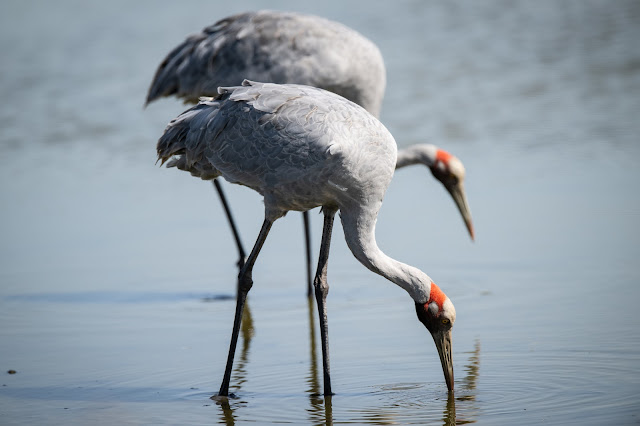Wednesday, 29 March 2023
Wild Bird Wednesday 557 - Brolga
Wednesday, 22 March 2023
Wild Bird Wednesday 556 - Royal Spoonbill
The Royal Spoonbill (Platalea regia) is one of the two species of Spoonbills found in Australia. This species has a black beak (and what a beak it is!), whereas the other species has a Yellow (or pale) bill. The second species is called the Yellow-billed Spoonbill, which is a very useful name!
This Royal Spoonbill was feeding at Werribee - and was moving very fast. It was moving backwards and forwards in the shallow water of a pool, and also moving its head from side to side. All in all there was a lot of motion!
In a couple of the shots you can see where the bird has left up its head, presumably after making contact with a food item. One of the shots shows the bird with a small fish.
There were at least 20 of these birds scattered around the edge of the pool, but this one was the most tolerant of my presence.
What a great bird!
As ever, to join in with WBW click on the link below. SM
You are invited to the Inlinkz link party!
Click here to enterWednesday, 15 March 2023
Wild Bird Wednesday 555 - Black Kite
I was lucky enough to spend some time with a family of Black Kites (Milvus migrans) this weekend. I assume they were 'a family' as they often interacted with each other, and the birds perched in the tree got rather excited when one of the other birds flew past. I assume that they were anticipating a feed!
Unfortunately for them - and possibly me - the feeding pass did not happen and the arrival of a couple of other cars and some passing vehicles towing boats moved the birds off. (I don't want to be grumpy, but is it too much to ask people to stay in their cars when they can see other people taking pictures!)
Anyway, this was one of the best opportunities I have had to photograph this species - its common enough, in fact its one of the most common birds of prey in the world - but I just tend to see them on the wing!
Kites were essentially restricted to one small part of the UK when I was a kid - Red Kites in this case - and it's great to know they have become much more common back in the UK. Both Black and Red Kites have a forked tail and you can see this in these pictures.
If you are a regular visitor to WBW, I dont need to tell you where I took the pictures!
As ever, to join in with WBW click on the blue button below. All wild birds are welcome! As are all wild bird photographers! SM
You are invited to the Inlinkz link party!
Click here to enterTuesday, 7 March 2023
Wild Bird Wednesday 554 - White-fronted Chat
The White-fronted Chat (Epthianura albifrons) is a common bird across the southern edge of Australia - yet it has taken me a while to get pictures of this species I am happy with.
It will come as no surprise that I took these pictures at Werribee Sewage Works - and its a legitimate question to ask if I bird anywhere else these days! (The response may actually be 'no')
Anyway, this bird can often be rather conspicuous as it perches on the tops of bushes. But I have also found it rather timid, in that it flys off to another bush if you stop and look at it! So, with a combination of a long lens and lots of megapixels, I managed to get these pictures.
This is the male of the species, the female was less cooperative.
I'm just back from six days of wilderness in Tasmania - so hope to catch up on comments soon.
As ever, to join in, click the button below. SM
You are invited to the Inlinkz link party!
Click here to enterWednesday, 1 March 2023
Wild Bird Wednesday 553 - Varied Sittella
The Varied Sittella (Daphoenositta chrysoptera) was known in the past as the Australian Nuthatch - and it's not hard to see why. For many years the Varied Sittella was classified in the same family as the nuthatches, but now it is considered different enough to have a family all of its own - the Neosittidae, and they are only found in Australasia.
Varied Sittellas come in a number of 'forms' (and there is still debate about classifying the forms as separate species) and this one is the Orange-Winged form. Unlike Nuthatches, Sittellas can be seen in small flocks.
This bird - and there were a few others with it - was rather high in some trees when I took these pictures - and I have to say I am surprised at the results.
The similarity between the Sittellas and Nuthatches is an example of convergent evolution, where two species end up with a set of similar features because they face the same set of challenges. In this case, running up and down tree branches and finding food hidden in the cracks and crevices of bark. I think its remarkable that both of these species have slightly up-turned bills.
Anyway: here are the pictures.
As ever, click on the link below to join in with WBW. SM
You are invited to the Inlinkz link party!
Click here to enter

































